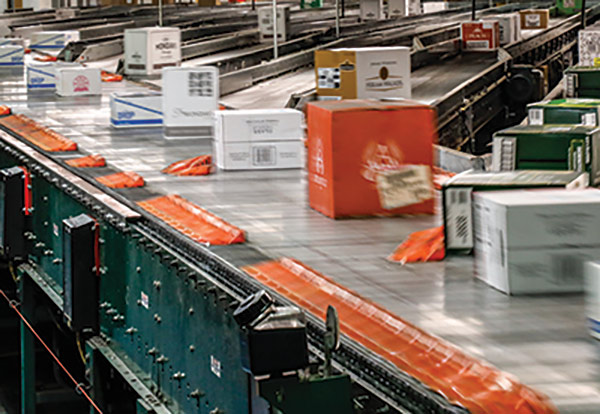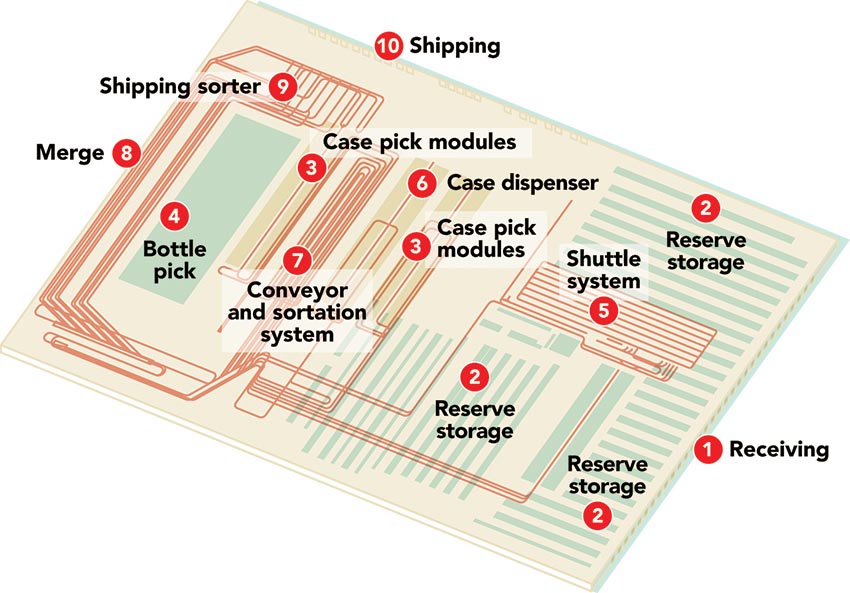Inside Southern Glazer’s Wine & Spirits’ DC: Meeting customer service requirements
Shuttle and case dispensing technologies help Southern Glazer’s Wine & Spirits keep up with demand in one of the most competitive markets in the country.

Southern Glazer’s Wine & Spirits
Syosset, N.Y.
SKUS: 13,000
Throughput: 10 million cases annually
Employees: 150
Shifts per day/Days per week: 3 shifts per day/5 days per week; 7 days per week during peak
Using shuttle technology and a unique case dispensing system, Southern Glazer’s Wine & Spirits is moving nearly 10 million cases a year through its Syosset, N.Y., distribution center, with most customers demanding next-day delivery.
Receiving
The facility receives (1) 10 million cases a year, which are delivered in truckload and container quantities. The facility receives 40 trucks a day during normal periods and as many as 50 per day during peak. Most product is received on slip sheets and transferred to pallets that receive a license plate bar code that is used by the warehouse management system (WMS) to determine a putaway location. Once received, pallets are staged for storage.
Storage
The putaway process is directed by the WMS. Depending on whether there is an immediate demand for product, pallets may be scanned into a rack or floor location in reserve storage (2); delivered to one of the case pick lines (3); or cases can be sent directly to the bottle pick room (4) where they are scanned into a location for split case picking, or conveyed to the shuttle system (5), where they are automatically inducted into the system.
Replenishment
During the day, pick locations are replenished according to rules that determine minimum and maximum inventory levels by SKU in the various picking areas; at night, during the active picking hours, pick locations are replenished according to demand.

Picking
There are four distinct picking processes in the facility.
- Case dispenser: The case dispenser area (6) is dedicated to the fastest-moving items in the facility and typically accounts for 20% of the nightly picking volume. Each line is fed by 24 accumulation lanes—or a total of 48 lanes across the two lines—with each lane dedicated to a specific SKU. Once picking begins, SKUs from the accumulation lanes are dispensed onto the takeaway conveyor as needed. Cases are automatically labeled with order and shipping information and then inducted onto the sortation system (7). Lights alert associates when an accumulation lane needs to be replenished.
- Traditional case pick: The facility features 13 case pick lines (3). Associates receive a pick sheet with picking instructions and labels. Cases are labeled and picked to a conveyor, which delivers them to the sortation system (7).
- Bottle pick room: The two-level bottle pick room (4) is reserved for mixed case orders. The fastest-moving items are picked on the floor level while slow-movers are aggregated on the mezzanine level. Orders are initiated on the ground level, where order selectors are directed by voice; cases then travel to the mezzanine level if slow-moving items are required or are inducted into the sortation system (7).
- Shuttle system: The shuttle system (5), which holds 25,000 cases, provides a way to aggregate and automate the storage and picking of the slowest moving SKUs as well as SKUs that are ordered in small quantities. Returns are also stored in the shuttle system, which creates a much more efficient returns putaway process.
Finally, some orders that are received early in the day can be put into the shuttle as buffer storage until picking begins in the evening. At that time, the WMS sends order information to the shuttle, which dispenses cases onto a conveyor system that delivers them to the sortation system (7).
Trailer loading and shipping: A total of 17 lines—nine from one area and eight from another—feed the accumulation and merge area (8). Once picking begins, cases are released, merged and combined in wave sequence to the sorter (9), which then conveys them in loading sequence to a dock door (10). Dock doors are feed by spiral conveyors. Trucks are floor-loaded on a first in/last off basis.
Read the Full Feature Article “Southern Glazer’s Wine & Spirits: Designed to Last”

Article Topics
Latest in Logistics
S&P Global Market Intelligence’s Rogers assesses 2024 import landscape Pitt Ohio exec warns Congress to go slow on truck electrification mandates Q1 intermodal volumes are up for second straight quarter, reports IANA Supply Chain Management Software: Build the foundation, deliver the value 2024 State of Freight Forwarders: What’s next is happening now Ryder opens up El Paso-based multi-client facility logistics facility Autonomous mobile robots (AMRs) on a mission to automate More LogisticsAbout the Author
Subscribe to Logistics Management Magazine

Find out what the world's most innovative companies are doing to improve productivity in their plants and distribution centers.
Start your FREE subscription today.
May 2024 Logistics Management

Latest Resources














